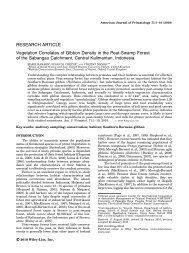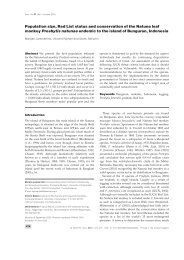Seasonal variation in naturally occurring mobbing ... - Vincent Nijman
Seasonal variation in naturally occurring mobbing ... - Vincent Nijman
Seasonal variation in naturally occurring mobbing ... - Vincent Nijman
You also want an ePaper? Increase the reach of your titles
YUMPU automatically turns print PDFs into web optimized ePapers that Google loves.
Mobb<strong>in</strong>g <strong>in</strong> drongos<br />
31<br />
bly year-round residents. More sedentary animals should mob more <strong>in</strong>tensely than<br />
less sedentary ones (SHERMAN 1977). Liv<strong>in</strong>g cont<strong>in</strong>uously on a territory or home<br />
range may mean that mobb<strong>in</strong>g to force a predator away is adaptive at all times of<br />
the year, because relocation to avoid further predator encounters is not possible.<br />
Thus, for sedentary species, the benefits of caus<strong>in</strong>g a predator to ‘move on’ would<br />
ma<strong>in</strong>ta<strong>in</strong> mobb<strong>in</strong>g at some basel<strong>in</strong>e level that will be <strong>in</strong>creased <strong>in</strong> the breed<strong>in</strong>g season,<br />
as mobb<strong>in</strong>g serves an additional function of protect<strong>in</strong>g the young. S<strong>in</strong>ce black<br />
eagles may pose a larger year round threat than the Javan hawk-eagle, vigorously<br />
attack<strong>in</strong>g them at any time may make evolutionary sense.<br />
Counter<strong>in</strong>tuitively this study suggest that black eagles may actually be less<br />
frequently mobbed dur<strong>in</strong>g the drongo’s breed<strong>in</strong>g season. An explanation for either<br />
the lack of seasonality <strong>in</strong> mobb<strong>in</strong>g towards black eagles, or even a decrease <strong>in</strong> mobb<strong>in</strong>g<br />
<strong>in</strong>tensity dur<strong>in</strong>g the drongo’s breed<strong>in</strong>g season, may be due to the specific<br />
threat that this eagle poses. Unlike most other bird-predat<strong>in</strong>g raptors, black eagles<br />
ma<strong>in</strong>ly predate on eggs and nestl<strong>in</strong>gs, and less so on fledgl<strong>in</strong>gs or adults. If black<br />
eagles make use of the <strong>in</strong>tensity of mobb<strong>in</strong>g <strong>in</strong> order to locate nests, as has been<br />
suggested for cuckoos (CRAIB 1994) and cowbirds (SMITH et al. 1984, but see GILL et<br />
al. 1997), reduced mobb<strong>in</strong>g dur<strong>in</strong>g the breed<strong>in</strong>g season may actually enhance the<br />
fitness of the drongos. The data from the present study are consistent with that of<br />
BURES & PAVEL (2003) and the hypothesis warrants further <strong>in</strong>vestigation.<br />
In conclusion, as noted <strong>in</strong> other studies, drongos are frequent mobbers<br />
towards potential predators, but possibly <strong>in</strong> response to different selection pressures<br />
certa<strong>in</strong> predators are more <strong>in</strong>tensely mobbed than others dur<strong>in</strong>g different<br />
phases of the breed<strong>in</strong>g cycle. This study suggests that mobb<strong>in</strong>g may also be related<br />
to the type of threat posed by the predator to the birds and/or their offspr<strong>in</strong>g.<br />
ACKNOWLEDGEMENTS<br />
The study was conducted <strong>in</strong> co-operation with the Directorate General for Forest Protection<br />
and Nature Conservation and the Indonesian Institute for Sciences. In this the help of<br />
Dr D.M. Prawiladilaga is greatly appreciated. F<strong>in</strong>ancial support was received from the<br />
Netherlands Commitee for International Nature Protection, Society for the Advancement of<br />
Scientific Research <strong>in</strong> the Tropics, P.A. Hens Memorial Fund, Mart<strong>in</strong>a de Beukelaar Sticht<strong>in</strong>g<br />
and J.C. van der Hucht Fonds. Dr S. van Balen, Dr B.A. Heuts, J.M. Lammert<strong>in</strong>k and S. Luisterburg<br />
are thanked for suggestions to improve the manuscript, as did S. Pavel and another<br />
anonymous reviewer.<br />
REFERENCES<br />
ARNOLD K.E. 2000. Group mobb<strong>in</strong>g and nest defense <strong>in</strong> a cooperatively breed<strong>in</strong>g Australian<br />
bird. Ethology 106: 385-393.<br />
BALEN S. VAN, NIJMAN V. & SÖZER R. 2001. Conservation of the endemic Javan Hawk-eagle<br />
Spizaetus bartelsi, Stresemann, 1924 (Aves: Falconiformes): density, age structure, and<br />
population numbers. Contributions to Zoology 70: 161-173.<br />
BURES S. & PAVEL V. 2003. Do birds behave <strong>in</strong> order to avoid disclos<strong>in</strong>g their nest site? Bird<br />
Study 50: 73-77.<br />
CURIO E. 1978. The adaptive significance of avian mobb<strong>in</strong>g: I Teleonomic hypothesis and predictions.<br />
Zeitschrift für Tierpsychologie 48: 175-183.










